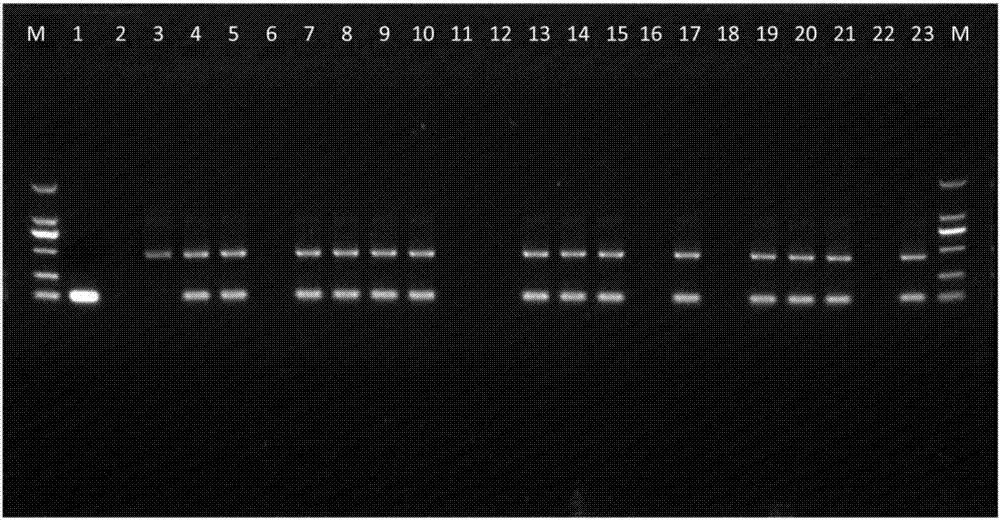Pear PbrmiR397a and application thereof
A technology of pear fruit and Dangshansu pear, which is applied in the field of plant genetic engineering, can solve the problems of limited research on MiRNAs, achieve the effects of reducing tobacco lignin synthesis, achieving environmental friendliness, and reducing agricultural costs
- Summary
- Abstract
- Description
- Claims
- Application Information
AI Technical Summary
Problems solved by technology
Method used
Image
Examples
Embodiment 1
[0030] Example 1 PbrmiR397a Gene Isolation and Cloning
[0031] DNA was extracted from the leaves of 'Dangshansuli' and used to amplify the precursor sequence of PbrmiR397a gene.
[0032] DNA was extracted using a plant genome extraction kit (purchased from Chengdu Fuji, operated according to the operating instructions provided by the kit). The amplification gene primer pair is SEQ ID No.2 and SEQ ID No.3. The 50 μL reaction system includes 200ngDNA, 1× buffer (TransStart FastPfu Buffer), 10mM dNTP, 1U Taq polymerase (TransStartFastPfu DNA Polymerase) (mentioned above Buffer and Taq polymerase were purchased from TRANS), 500 nM of the above primers. The PCR reaction was completed on the eppendorf amplification instrument according to the following program: 95°C, pre-denaturation for 2 minutes, denaturation at 95°C for 20 seconds, annealing at 60°C for 20 seconds, extension at 72°C for 30 seconds, 35 thermal cycles, extension at 72°C for 10 minutes, Store at 4°C. Produces a ...
Embodiment 2
[0034] Example 2 Construction of Plant Transformation Overexpression Vector
[0035] The multiple cloning site of pCAMBIA-1301 vector and the restriction site analysis on the precursor sequence of PbrmiR397a gene selected Bgl II and BstE II as endonucleases. According to the general principles of primer design, primers with restriction sites were designed with Primer Primer 3.0 software, and the primer pair sequences were SEQ ID NO.4 and SEQ ID NO.5. Using the extracted plasmid from the preserved bacterial liquid with correct sequencing as a template, the gene containing the restriction enzyme site was cloned. The annealing temperature of PCR amplification is 60° C., and the PCR reaction system and amplification procedure are the same as in Example 1. Recover the target band and connect it to the pEASY vector. The total volume of the double digestion system is 40 μL, which contains 12 μL of pEASY-PbrmiR397a plasmid, 4 μL of 10×K Buffer (purchased from NEB Company), 0.8 μL of...
Embodiment 3
[0036] Example 3 Genetic transformation of tobacco and molecular identification of transformed plants
[0037] The specific steps of tobacco genetic transformation mediated by Agrobacterium tumefaciens refer to Dr. Xiaosan Huang's graduation thesis (2012) [9]. Tobacco plants transformed with PbrmiR397a were obtained according to the above method, and the total DNA of leaves of the tobacco plants was extracted by a small amount method, which was used as a template, and the positive seedlings were identified by PCR amplification using a pair of cloning primers. Reaction program: denaturation at 94°C for 3 minutes, pre-denaturation at 94°C for 30 seconds, annealing at 60°C for 30 seconds, extension at 72°C for 30 seconds, 35 cycles, and extension at 72°C for 10 minutes after the cycle was completed. Tobacco transgenic plant identification see image 3 .
[0038] Analysis of PbrmiR397a expression level in transgenic tobacco:
[0039] The expression level of exogenous genes in t...
PUM
 Login to View More
Login to View More Abstract
Description
Claims
Application Information
 Login to View More
Login to View More - R&D
- Intellectual Property
- Life Sciences
- Materials
- Tech Scout
- Unparalleled Data Quality
- Higher Quality Content
- 60% Fewer Hallucinations
Browse by: Latest US Patents, China's latest patents, Technical Efficacy Thesaurus, Application Domain, Technology Topic, Popular Technical Reports.
© 2025 PatSnap. All rights reserved.Legal|Privacy policy|Modern Slavery Act Transparency Statement|Sitemap|About US| Contact US: help@patsnap.com



